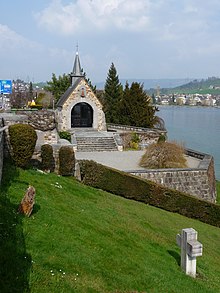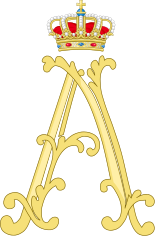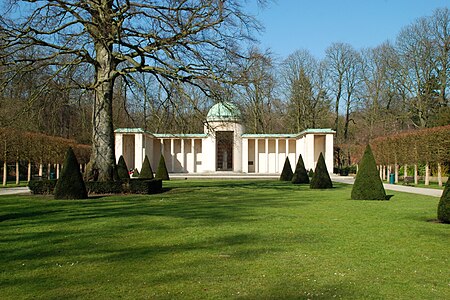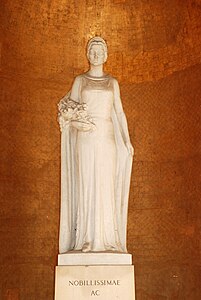Astrid of Sweden
This article has multiple issues. Please help improve it or discuss these issues on the talk page. (Learn how and when to remove these template messages)
|
| Astrid of Sweden | |||||
|---|---|---|---|---|---|
Küssnacht am Rigi, Schwyz, Switzerland | |||||
| Burial | 3 September 1935 , Belgium | ||||
| Spouse | |||||
| Issue | |||||
| |||||
| House | Bernadotte | ||||
| Father | Prince Carl, Duke of Västergötland | ||||
| Mother | Princess Ingeborg of Denmark | ||||
Astrid of Sweden (17 November 1905 – 29 August 1935) was a member of the Swedish House of Bernadotte and later became Queen of the Belgians as the first wife of King Leopold III. Following her marriage to Leopold in November 1926, she assumed the title of Duchess of Brabant.[2] Astrid held the position of Queen of the Belgians from 23 February 1934 until her death in 1935. Known for her charitable efforts, she focused particularly on causes related to women and children.
Astrid and Leopold had three children. Their daughter,
Early life

Princess Astrid was born on 17 November 1905 at her parents’ then-residence, the
Astrid had two elder sisters,
Astrid grew up with her sisters and younger brother at Byström's Villa (also known as Prince Carl's Palace) on the island Djurgården in central Stockholm until 1923, when the family had to leave the house for financial reasons. From 1909, holidays were spent at the family's summer residence Villa Fridhem' by Bråviken, a bay of the Baltic Sea near Norrköping. Astrid was raised with a strict education and little luxury. She attended the Sint Botvid boarding school, where lessons were taught in French, then went on to the Akerstrom-Soderstrom finishing school, where she studied sewing, piano, ballet and childcare.[5] After she finished school, Astrid worked at a Stockholm orphanage where she cared for children.[6]
Engagement and wedding

Due to her royal status, Astrid was named as a potential bride for a number of princes, including the future
In September 1926, her engagement with Prince Leopold of Belgium, Duke of Brabant was announced. The King said: "The Queen and I would like to announce to you the impending marriage between Prince Leopold, Duke of Brabant, and Princess Astrid of Sweden. We are convinced that the princess will bring joy and happiness to our son. Leopold and Astrid have decided to join their lives without any pressures or reasons of state. Theirs is a true union among people with the same inclinations." Queen Elizabeth said: "It is a marriage of love... tell it to our people. Nothing was arranged. Not a single political consideration prevailed in our son's decision."

Princess Astrid entered into a
Princess Astrid was given a tiara created by Belgian jeweler Van Bever as a wedding gift from the Belgian government. The original version of the diadem is a flexible diamond bandeau in a stylized
Duchess of Brabant

The Duke and Duchess of Brabant spent their honeymoon in the

In October 1927, Leopold and Astrid had a daughter,
Raised as a
In 1932, Astrid and her husband traveled to
The Duchess of Brabant became a godmother to Anna Sparre's daughter, Christina,[15] and her sister Crown Princess Märtha's second daughter, Princess Astrid.[citation needed]
Queen
On 17 February 1934, King Albert I died in a
As Queen of the Belgians, Astrid dedicated her time to raising her children and promoting social causes that brought her into contact with the Belgians. She was concerned by the situation of women, children, and disadvantaged people. During an economic crisis in Belgium in 1935 she organized the collection of clothing, money and food for the poor through an open letter, published as the "Queen’s Appeal". Queen Astrid also visited poor settlements in Belgium.[14]
Queen Astrid was particularly interested in training women formally in childcare and healthcare.
In May 1935, Queen Astrid patronized Milk Week, an effort to encourage Belgians to drink healthy beverages. She charged Gatien du Parc, one of her courtiers, with the task of preparing a detailed report on milk regulations in foreign countries after a strict investigation.
Hobbies and personality
Queen Astrid had a warm, friendly, social and charming personality.[citation needed] According to her friend Countess Anna Sparre, Astrid was a shy and insecure woman—a disposition she believes may have been influenced by Astrid's mother favoring her elder sister Märtha.[14] Apparently a timid and fragile woman, Astrid could be fierce and stern when she had to defend a wronged loved one.[18]
She collected Swedish folk art and enjoyed sports such as
Death

Astrid died on 29 August 1935 in a car accident at
In August 1935, the King and Queen went incognito to their holiday home, Villa Haslihorn in Horw, on the shores of Lake Lucerne, Switzerland. Joséphine-Charlotte and Baudouin travelled with their parents, while the one-year-old Prince Albert remained in Brussels.
On 29 August 1935, the King and Queen went for a last hike in the mountains before returning home. Their chauffeur was sitting in the back of the Packard One-Twenty convertible; the King was driving and the Queen looking at a map. At approximately 9:30 am the Queen pointed out something to her husband, who looked away from the road. The car left the road, travelled down a steep slope, and collided with a pear tree. Queen Astrid had opened her door and was thrown out upon impact, striking the trunk of the tree while the car hit a second tree.
Queen Astrid is interred in the royal vault at the Church of Our Lady of Laeken, Brussels, beside her husband, King Leopold III, and his second wife, Lilian, Princess of Réthy.
Legacy
Folklore
Memorials

In 1935, the Belgian postal authorities issued a postage stamp showing her portrait outlined in black. This is known as the Astrid Mourning issue. Later that same year, it released a series of anti-tuberculosis fund stamps with the same design.[21] Place de la Reine-Astrid in 8th arrondissement of Paris was named in her memory.[22]
A commemorative chapel named Astrid Chapel
A memorial was built by the architect Paul Bonduelle in Laeken, Belgium, and inaugurated on 21 July 1938. The building, which is in the late neo-classical style, faces the Church of Our Lady of Laeken and backs onto the Palace of Laeken. The same year, on the initiative of the local Veterans' Front, a bronze bust of the Queen was erected in Wisterzée Park in Court-Saint-Étienne, Belgium, by sculptor Victor Rousseau.[citation needed]
Astrid Avenue in
Names
Four of her descendants were named Astrid to honour her: her granddaughters
Gallery
-
Statue of Astrid in a park at Kortrijk named for her.
-
Queen Astrid Memorial in Laeken
(architect Paul Bonduelle, 1938). -
Statue of the Queen in the Queen Astrid Memorial in Laeken.
-
Arms
 Alliance Coat of Arms of King Leopold III and Queen Astrid of Belgium |
 Royal Monogram of Queen Astrid of Belgium |
Ancestry
| Ancestors of Astrid of Sweden | ||||||||||||||||||||||||||||||||||||||||||||||||||||||||||||||
|---|---|---|---|---|---|---|---|---|---|---|---|---|---|---|---|---|---|---|---|---|---|---|---|---|---|---|---|---|---|---|---|---|---|---|---|---|---|---|---|---|---|---|---|---|---|---|---|---|---|---|---|---|---|---|---|---|---|---|---|---|---|---|
| ||||||||||||||||||||||||||||||||||||||||||||||||||||||||||||||
References
Citations
- ISBN 0 85011 023 8p. 514 (spelling of her full name as baptized)
- ^ a b c d "Princess Astrid". www.kungahuset.se. Retrieved 11 August 2022.
- ^ "Ingeborg of Denmark (1878–1958) | Encyclopedia.com". www.encyclopedia.com. Retrieved 21 February 2024.
- ^ "Astrid of Sweden (1905–1935) | Encyclopedia.com". www.encyclopedia.com. Retrieved 26 June 2023.
- ^ Bloks, Moniek (20 June 2018). "Astrid of Sweden - Queen of Hearts". History of Royal Women. Retrieved 21 February 2024.
- ^ Abi, Jo (7 August 2020). "The short and tragic life of Queen Astrid of Belgium". Retrieved 15 April 2021.
- ^ "Mathilde, queen of Belgium | Facts, Biography, & Children | Britannica". www.britannica.com. Retrieved 26 June 2023.
- ^ a b Bloks, Moniek (20 June 2018). "Astrid of Sweden - Queen of Hearts". History of Royal Women. Retrieved 21 February 2024.
- ^ a b Priherdityo, Endro (16 March 2016). "Kisah Cinta Putri Belgia Masih Tersimpan di Kebun Raya Bogor" [The Memory of Belgian Princess's Love Story Is Still Saved in the Bogor Botanical Garden]. CNN Indonesia (in Indonesian). Retrieved 23 October 2018.
- ^ a b c d e f g h Janti, Nur (17 June 2020). "Kunjungan Putra Mahkota Belgia Leopold dan Putri Astrid ke Hindia Belanda" [Visit of the Belgian Crown Prince Leopold and Princess Astrid to the Dutch East Indies]. Historia (in Indonesian). Retrieved 30 May 2021.
- ^ More Joy Than Pain, 1991, by Lars Rooth pp. 84–85
- ^ Quoted by Anna Sparre in Astrid mon amie, 2005, p. 128
- ^ Quoted by Charles d'Ydewalle in Albert and the Belgians: Portrait of a King, 2005, p. 259
- ^ a b c Sparre, Anna. Astrid mon amie. 2005.
- ^ Sparre, Anna. Astrid mon amie. 2005. ""But I promised I would look after my god-daughter, Christina, if something happened to you," she answered, trying to smile."
- ^ a b c d e Koninckx, Christian; Libert-Vandenhove, Louise-Marie. Astrid: 1905-1935 (2005). pp. 103-115.
- ^ "Koningin Astrid van België (1935)" (in Dutch). 18 April 2019. Archived from the original on 11 December 2021. Retrieved 3 April 2021 – via YouTube.
- ^ Sparre, Anna. Astrid mon amie. 2005. p. 114
- Aberdeen Press and Journal. No. 25, 167. 30 August 1935. p. 7 – via British Newspaper Archive.
- ^ a b c d e f Réactions à la mort de la reine Astrid, 1905-1935, document of historian Alexei Schwarzenbach.
- ^ Stanley Gibbons Simplified catalogue. Stamps of the World, 1985 Edition
- ^ "LA PLACE DE LA REINE ASTRID". paristoric.com (in French). Retrieved 15 April 2021.
- ^ "ASTRID KAPELLE KÜSSNACHT AM RIGI". zug-tourismus.ch. Archived from the original on 22 November 2021. Retrieved 15 April 2021.
- ^ "Astrid Kapelle, Küssnacht am Rigi". rigi.ch.
- ^ "Bericht über den Besuch des Belgischen Königs Albert II. in Küssnacht". Neue Zürcher Zeitung. 29 August 2010. Retrieved 6 February 2017.
- ^ a b Der belgische König kommt nach Küssnacht Archived 26 April 2012 at the Wayback Machine Neue Zürcher Zeitung
- ^ Schwarzenbach, Alexei (1998). Rêves Royaux. Réactions à la mort de la reine Astrid, 1905-1935 . p. 22.
- ^ "Mort de la reine Astrid: le roi des Belges sur les lieux du drame" [Death of Queen Astrid: the King of the Belgians at the scene of the tragedy]. tdg.ch (in French). 29 August 2015.
- ^ "Taman Astrid - Kebun Raya Bogor". Lovely Bogor (in Indonesian).
- ^ "Traditionsenlig tårtfrossa - Prinsessyra bäddar för prinsesstårtans vecka" (in Swedish). Cisionwire. 17 September 2009. Archived from the original on 17 October 2010. Retrieved 19 December 2009.
- ^ Vera (24 February 2009). "Swedish Princess Cake". Retrieved 26 January 2014.
- ^ "Princess Astrid celebrates her 80th birthday". Norwegian Royal House. 11 February 2012. Archived from the original on 23 November 2021. Retrieved 28 September 2019.
Bibliography
- Catherine Barjansky. "Portraits with Backgrounds."
- Art Beeche. "The Snow Princess."
- Robert Capelle. "Dix-huit ans auprès du Roi Léopold."
- Charles d'Ydewalle. "Albert and the Belgians: Portrait of a King."
- Evelyn Graham. "Albert King of the Belgians."
- Lerche, Anna; Mandal, Marcus (2003). A royal family : the story of Christian IX and his European descendants. Copenhagen: Aschehoug. ISBN 9788715109577.
- Luciano Regolo. "La Regina Incompresa."
- Lars Rooth. "More Joy Than Pain."
- Sparre, Anna (2005). Astrid, mon amie (in French). Brussels: Luc Pire. ISBN 9782874155161.
External links
- Royal Love Match (1926), newsreel on the British PathéYouTube Channel
- Tragic Death of the Queen of the Belgians (1935), newsreel on the British PathéYouTube Channel
- Portraits of the Nation: Postage Stamps and National Identity
- The making of a Belgicist reference to Villa Haslihorn
- Packard Club images from the Packard car after the accident
- BELGIUM: Death of Astrid Time article
- Newspaper clippings about Astrid of Sweden in the 20th Century Press Archives of the ZBW




